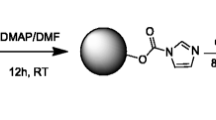Abstract
Acrylamide (AA) has been classified as a probable human carcinogen and forms in certain foods, particularly plant-based foods that are rich in carbohydrates and low in proteins, during processing or cooking at high temperatures. In this study, polyclonal antibodies were raised against a hapten derived from acrylamide and 3-mercaptobenzoic acid (3-MBA). An indirect competitive enzyme-linked immunosorbent assay was developed to rapidly quantify AA in complex food matrices and water. The assay was very specific to the AA-3-MBA derivative and showed no cross-reactivity to asparagine, the main precursor of AA formation in foods, aspartic acid, AA, or 3-MBA. The assay was very sensitive with a limit of detection of 5.0 ng/g in model for food matrices to 0.1 μg/L in water. Good recoveries for AA were observed in all matrices tested, and the results using this method were comparable to those obtained from mass spectrometry methods including Food Analysis Performance Assessment Scheme control samples and results for different food products.


Similar content being viewed by others
References
Becalski A, Lau BPY, Lewis D, Seaman SW (2003) Acrylamide in foods: occurrence, sources, and modeling. J Agric Food Chem 51(3):802–808
Becalski A, Lau BPY, Lewis D, Seaman SW, Hayward S, Sahagian M, Ramesh M, Leclerc Y (2004) Acrylamide in French fries: influence of free amino acids and sugars. J Agric Food Chem 52(12):3801–3806
EC (1998) European Council, European Council drinking water directive EU 98/83/EC, Brussels
EC (2007) European Commission Recommendation of 3 May 2007 on the monitoring of acrylamide levels in food 2007/331/EC. Off J Eur Union L123:33–40
Friedman M (2003) Chemistry, biochemistry, and safety of acrylamide. A review. J Agric Food Chem 51(16):4504–4526
IARC (1994) IARC monographs programme on the evaluation of carcinogenic risks to humans. IARC Monogr Eval Carcinog Risks Hum 60:13–33
JECFA (2011) Joint FAO/WHO Expert Committee on Food Additives (JECFA): JECFA review (monograph 8)
Mottram DS, Wedzicha BL, Dodson AT (2002) Food chemistry: acrylamide is formed in the Maillard reaction. Nature 419(6906):448–449
Preston A, Fodey T, Elliott C (2008) Development of a high-throughput enzyme-linked immunosorbent assay for the routine detection of the carcinogen acrylamide in food, via rapid derivatisation pre-analysis. Anal Chim Acta 608(2):178–185
Quan Y, Chen M, Zhan Y, Zhang G (2011) Development of an enhanced chemiluminescence ELISA for the rapid detection of acrylamide in food products. J Agric Food Chem 59(13):6895–6899
Singh KV, Kaur J, Varshney GC, Raje M, Suri CR (2004) Synthesis and characterization of hapten-protein conjugates for antibody production against small molecules. Bioconjug Chem 15(1):168–173
Stadler RH, Blank I, Varga N, Robert F, Hau J, Guy PA, Robert MC, Riediker S (2002) Food chemistry: acrylamide from Maillard reaction products. Nature 419(6906):449–450
Taeymans D, Wood J, Ashby P, Blank I, Studer A, Stadler RH, Gondé P, Van Eijck P, Lalljie S, Lingnert H et al (2004) A review of acrylamide: an industry perspective on research, analysis, formation, and control. Crit Rev Food Sci Nutr 44(5):323–347
Wenzl T, de la Calle MB, Anklam E (2003) Analytical methods for the determination of acrylamide in food products: a review. Food Addit Contam 20(10):885–902
WHO (2003) World Health Organization guidelines for drinking water quality, vol. 1: recommendations, 2nd edn., Geneva
Zhou S, Zhang C, Wang D, Zhao M (2008) Antigen synthetic strategy and immunoassay development for detection of acrylamide in foods. Analyst 133(7):903–909
Acknowledgments
The authors give sincere thanks to Dr. Xu-Liang Cao and Dr. Zhongwen Wang for their helpful comments during the editing of this manuscript.
Conflict of Interest
Gurmit Singh has no conflict of interest. Beth Brady has no conflict of interest. Terry Koerner has no conflict of interest. Adam Becalski has no conflict of interest. Tony Zhao has no conflict of interest. Sherry Feng has no conflict of interest. Samuel Benrejeb Godefroy has no conflict of interest. Anne-Catherine Huet has no conflict of interest. Philippe Delahaut has no conflict of interest. All institutional and national guidelines for the care and use of laboratory animals were followed.
Author information
Authors and Affiliations
Corresponding author
Rights and permissions
About this article
Cite this article
Singh, G., Brady, B., Koerner, T. et al. Development of a Highly Sensitive Competitive Indirect Enzyme-Linked Immunosorbent Assay for Detection of Acrylamide in Foods and Water. Food Anal. Methods 7, 1298–1304 (2014). https://doi.org/10.1007/s12161-013-9749-7
Received:
Accepted:
Published:
Issue Date:
DOI: https://doi.org/10.1007/s12161-013-9749-7




